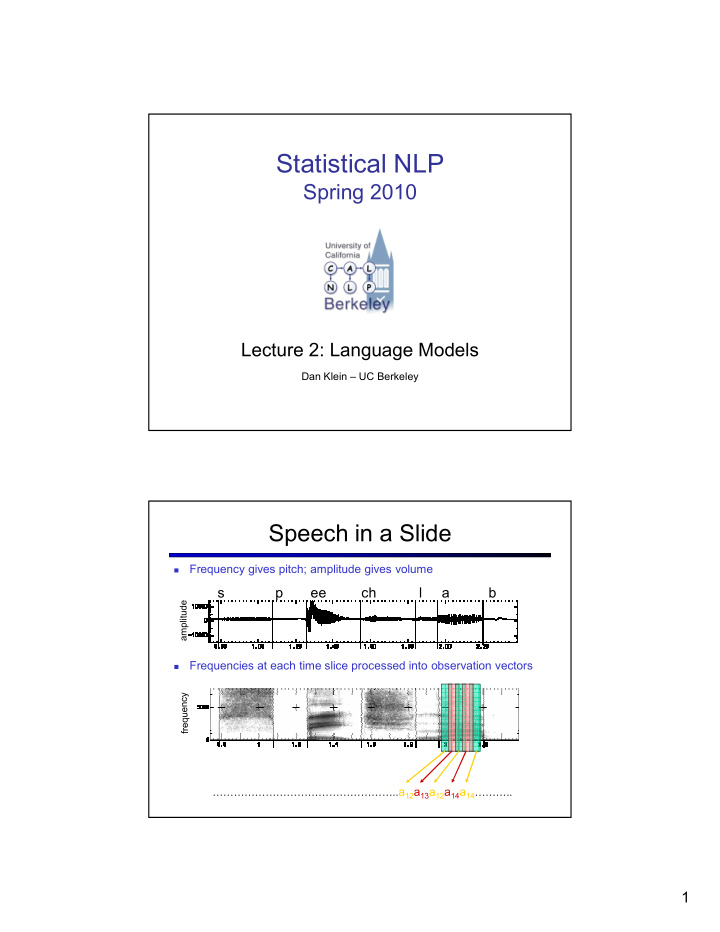



Statistical�NLP Spring�2010 Lecture�2:�Language�Models Dan�Klein�– UC�Berkeley Speech�in�a�Slide Frequency�gives�pitch;�amplitude�gives�volume � s�������������p�������ee���������ch�����������l�����a����������b amplitude Frequencies�at�each�time�slice�processed�into�observation�vectors � …………………………………………….. a 12 a 13 a 12 a 14 a 14 ……….. 1
The�Noisy-Channel�Model � We�want�to�predict�a�sentence�given�acoustics: � The�noisy�channel�approach: Acoustic�model:�HMMs�over� Language�model:� word�positions�with�mixtures� Distributions�over�sequences� of�Gaussians�as�emissions of�words�(sentences) Acoustically�Scored�Hypotheses the�station�signs�are�in�deep�in�english -14732 the�stations�signs�are�in�deep�in�english -14735 the�station�signs�are�in�deep�into�english -14739 the�station�'s�signs�are�in�deep�in�english -14740 the�station�signs�are�in�deep�in�the�english -14741 the�station�signs�are�indeed�in�english -14757 the�station�'s�signs�are�indeed�in�english -14760 the�station�signs�are�indians�in�english -14790 the�station�signs�are�indian�in�english -14799 the�stations�signs�are�indians�in�english -14807 the�stations�signs�are�indians�and�english -14815 2
ASR�System�Components �������������� �������������� ������� ������ � � ������ ���� ������������� ���� ������� � � ��������������������������������� � � Translation:�Codebreaking? � “Also�knowing�nothing�official�about,�but�having� guessed�and�inferred�considerable�about,�the� powerful�new�mechanized�methods�in� cryptography—methods�which�I�believe�succeed� even�when�one�does�not�know�what�language�has� been�coded—one�naturally�wonders�if�the�problem� of�translation�could�conceivably�be�treated�as�a� problem�in�cryptography.��When�I�look�at�an�article� in�Russian,�I�say:�‘This�is�really�written�in�English,� but�it�has�been�coded�in�some�strange�symbols.�I� will�now�proceed�to�decode.’��”� � Warren�Weaver�(1955:18,�quoting�a�letter�he�wrote�in�1947) 3
MT�Overview � MT�System�Components �������������� ����������������� ������� ������ � � ������ ���� ������������� ���� ������� � � ��������������������������������� � � 4
Other�Noisy-Channel�Processes � Spelling�Correction ∝ � � ����� � ���������� � � � ����� � � � ���������� � ����� � � Handwriting�recognition ∝ � � ����� � ������� � � � ����� � � � ������� � ����� � � OCR ∝ � � ����� � ������ � � � ����� � � � ������ � ����� � � More… Probabilistic�Language�Models � Goal:�Assign�useful�probabilities�P(x)�to�sentences�x � Input:�many�observations�of�training�sentences�x � Output:�system�capable�of�computing�P(x) � Probabilities�should�broadly�indicate�plausibility�of�sentences � P(I�saw�a�van)�>>�P(eyes�awe�of�an) � ������������������ :�P(artichokes�intimidate�zippers)� ≈ 0 � In�principle,�“plausible”�depends�on�the�domain,�context,�speaker… � One�option:�empirical�distribution�over�training�sentences? � Problem:�doesn’t�generalize�(at�all) � Two�aspects�of�generalization � Decomposition:�break�sentences�into�small�pieces�which�can�be� recombined�in�new�ways�(conditional�independence) � Smoothing:�allow�for�the�possibility�of�unseen�pieces 5
N-Gram�Model�Decomposition � Chain�rule:�break�sentence�probability�down � Impractical�to�condition�on�everything�before � P(???�|�Turn�to�page�134�and�look�at�the�picture�of�the)�? � N-gram�models:�assume�each�word�depends�only�on�a� short�linear�history � Example:� N-Gram�Model�Parameters � The�parameters�of�an�n-gram�model: � The�actual�conditional�probability�estimates,�we’ll�call�them� θ � Obvious�estimate:� ������������������� ( ������������������ )� �������� � General�approach � Take�a�training�set�X�and�a�test�set�X’ � Compute�an�estimate� θ from�X � Use�it�to�assign�probabilities�to�other�sentences,�such�as�those�in�X’ 198015222�the�first 194623024�the�same Training�Counts 168504105�the�following 158562063�the�world … 14112454�the�door ----------------- 23135851162�the�* 6
Higher�Order�N-grams? Please�close�the�door Please�close�the�first�window�on�the�left 198015222�the�first 197302�close�the�window� 3380�please�close�the�door 194623024�the�same 191125�close�the�door� 1601�please�close�the�window 168504105�the�following 152500�close�the�gap� 1164�please�close�the�new 158562063�the�world 116451�close�the�thread� 1159�please�close�the�gate … 87298�close�the�deal 900�please�close�the�browser 14112454�the�door ----------------- ----------------- ----------------- 3785230 close�the�* 13951�please�close�the�* 23135851162�the�* Unigram�Models � Simplest�case:�unigrams � Generative�process:�pick�a�word,�pick�a�word,�…�until�you�pick�STOP � As�a�graphical�model: � � � � � � �� ���� …………. � Examples: � [fifth,�an,�of,�futures,�the,�an,�incorporated,�a,�a,�the,�inflation,�most,�dollars,�quarter,�in,�is,�mass.] � [thrift,�did,�eighty,�said,�hard,�'m,�july,�bullish] � [that,�or,�limited,�the] � [] � [after,�any,�on,�consistently,�hospital,�lake,�of,�of,�other,�and,�factors,�raised,�analyst,�too,�allowed,� mexico,�never,�consider,�fall,�bungled,�davison,�that,�obtain,�price,�lines,�the,�to,�sass,�the,�the,�further,� board,�a,�details,�machinists,�the,�companies,�which,�rivals,�an,�because,�longer,�oakes,�percent,�a,� they,�three,�edward,�it,�currier,�an,�within,�in,�three,�wrote,�is,�you,�s.,�longer,�institute,�dentistry,�pay,� however,�said,�possible,�to,�rooms,�hiding,�eggs,�approximate,�financial,�canada,�the,�so,�workers,� advancers,�half,�between,�nasdaq] 7
Recommend
More recommend